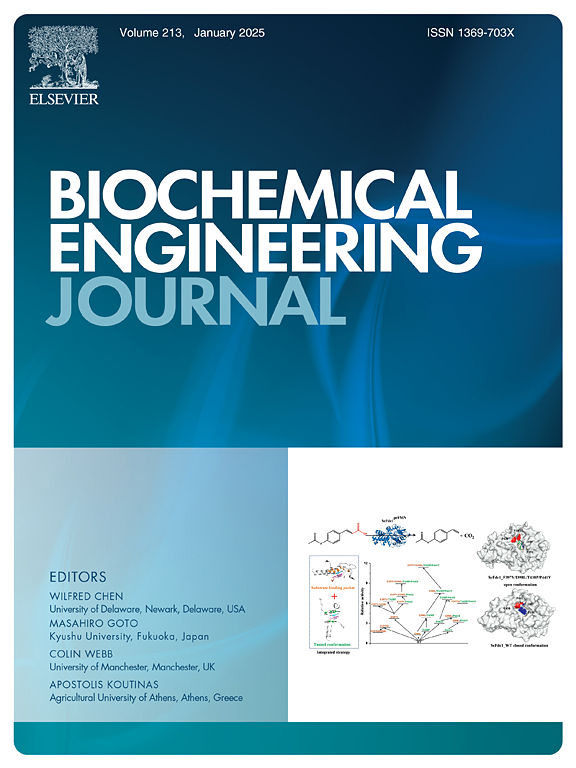对相邻甘蔗厂生产第一代和第二代生物乙醇的整合和预处理方案进行评估
IF 3.7
3区 生物学
Q2 BIOTECHNOLOGY & APPLIED MICROBIOLOGY
引用次数: 0
摘要
从甘蔗糖蜜和木质纤维素中合成的第一代和第二代生物乙醇(1G2G)为支持运输和化学部门的脱碳提供了一条经济和环境可行的途径。利用相邻工厂提供的原料的规模经济效益,评估了甘蔗生物精炼厂的季节性和全年运营的技术经济绩效。考虑了五种不同的1G2G配置,这些配置在糖利用策略、预处理技术和磨间原料物流方面有所不同。由于提高了资本利用率,采用全年运营将最低乙醇销售价格(MESP)降低了11. %。尽管具有最低的MESP(1.16美元/升),但由于生物质存储空间的要求,淡季使用木质纤维素存储被认为是不切实际的。添加来自相邻工厂的原料可使mesp降低11-22 %,当仅在主工厂加工C5糖时,与2家工厂整合可使mesp降低32 %。液体热水(LHW)预处理结合热水循环和C5和C6糖的共发酵是最具成本效益和实用的方案(MESP = 1.25美元/升)。热水回收在减少能源(1.2 GJ/吨生物质)和水需求(减少50% %)方面是有效的。在LHW预处理中,固体载荷加倍可使MESP降低11% %以上,表明其具有强化工艺的潜力。与以往的研究不同,区域工厂整合的效益是量化的。本文章由计算机程序翻译,如有差异,请以英文原文为准。
Evaluating integration and pretreatment options, for first- and second-generation bioethanol production by adjacent sugarcane mills
Integrated first- and second-generation (1G2G) bioethanol production from sugarcane molasses and lignocelluloses offers an economic and environmentally viable pathway to support decarbonisation of the transport and chemical sectors. The techno-economic performance of on-season versus year-round operation of a sugarcane biorefinery, leveraging the economies of scale benefits of using feedstock supplied by adjacent mills were assessed. Five different 1G2G configurations, varying in terms of sugar utilisation strategies, pretreatment technologies and inter-mill feedstock logistics were considered. Adopting year-round operation reduced the minimum ethanol selling price (MESP) by 11 %, compared to on-season only operation due to improved capital utilisation. Despite having the lowest MESP (1.16 US$/L), lignocelluloses storage for off-season use was deemed impractical due to biomass storage space requirements. Adding feedstock from one adjacent mill reduced MESPs by 11–22 %, and by 32 % for integration with 2 mills when only processing C5 sugars at host-mill. Liquid hot water (LHW) pretreatment coupled with hot water recycling and co-fermentation of C5 and C6 sugars was the most cost-effective and practical scenario (MESP = 1.25 US$/L). Hot water recycling was effective in reducing the energy (1.2 GJ/tonne biomass) and water demand (less 50 %). Doubling solids loading in LHW pretreatment reduced the MESP by over 11 %, demonstrating its potential for process intensification. Unlike previous studies, the benefits of regional mill integration were quantified.
求助全文
通过发布文献求助,成功后即可免费获取论文全文。
去求助
来源期刊

Biochemical Engineering Journal
工程技术-工程:化工
CiteScore
7.10
自引率
5.10%
发文量
380
审稿时长
34 days
期刊介绍:
The Biochemical Engineering Journal aims to promote progress in the crucial chemical engineering aspects of the development of biological processes associated with everything from raw materials preparation to product recovery relevant to industries as diverse as medical/healthcare, industrial biotechnology, and environmental biotechnology.
The Journal welcomes full length original research papers, short communications, and review papers* in the following research fields:
Biocatalysis (enzyme or microbial) and biotransformations, including immobilized biocatalyst preparation and kinetics
Biosensors and Biodevices including biofabrication and novel fuel cell development
Bioseparations including scale-up and protein refolding/renaturation
Environmental Bioengineering including bioconversion, bioremediation, and microbial fuel cells
Bioreactor Systems including characterization, optimization and scale-up
Bioresources and Biorefinery Engineering including biomass conversion, biofuels, bioenergy, and optimization
Industrial Biotechnology including specialty chemicals, platform chemicals and neutraceuticals
Biomaterials and Tissue Engineering including bioartificial organs, cell encapsulation, and controlled release
Cell Culture Engineering (plant, animal or insect cells) including viral vectors, monoclonal antibodies, recombinant proteins, vaccines, and secondary metabolites
Cell Therapies and Stem Cells including pluripotent, mesenchymal and hematopoietic stem cells; immunotherapies; tissue-specific differentiation; and cryopreservation
Metabolic Engineering, Systems and Synthetic Biology including OMICS, bioinformatics, in silico biology, and metabolic flux analysis
Protein Engineering including enzyme engineering and directed evolution.
 求助内容:
求助内容: 应助结果提醒方式:
应助结果提醒方式:


